Chip stocks fall with Nvidia after data center rev disappointment
Introduction & Market Context
Innate Pharma (EPA:IPH) (EURONEXT:IPH.PA, NASDAQ: IPHA) presented its Q1 2025 Business Update and Financial Results on May 13, 2025, highlighting progress across its oncology and immunology pipeline. The company’s stock traded at $2.01, down 0.5% on the day, within its 52-week range of $1.33-$2.79.
The clinical-stage biopharmaceutical company, with a market capitalization of approximately $776.66 million, continues to advance its proprietary technology platforms while strengthening strategic partnerships to support its development programs.
Executive Summary
Innate Pharma’s Q1 2025 presentation outlined the company’s focus on three strategic growth pillars: NK-cell engagers, Antibody Drug Conjugates (ADCs), and current late-stage assets. The company reported a cash position of €72.5 million as of March 31, 2025, providing runway until mid-2026, further bolstered by a €15 million equity investment from Sanofi (NASDAQ:SNY) completed in April 2025.
Key highlights included the FDA Breakthrough Therapy Designation for Lacutamab in February 2025, ongoing Phase 1 trials for IPH6501 (CD20-targeted NK cell engager) and IPH4502 (Nectin-4 ADC), and the strengthened strategic relationship with Sanofi, which now holds a 9.05% stake in the company.
As shown in the following strategic pillars overview:
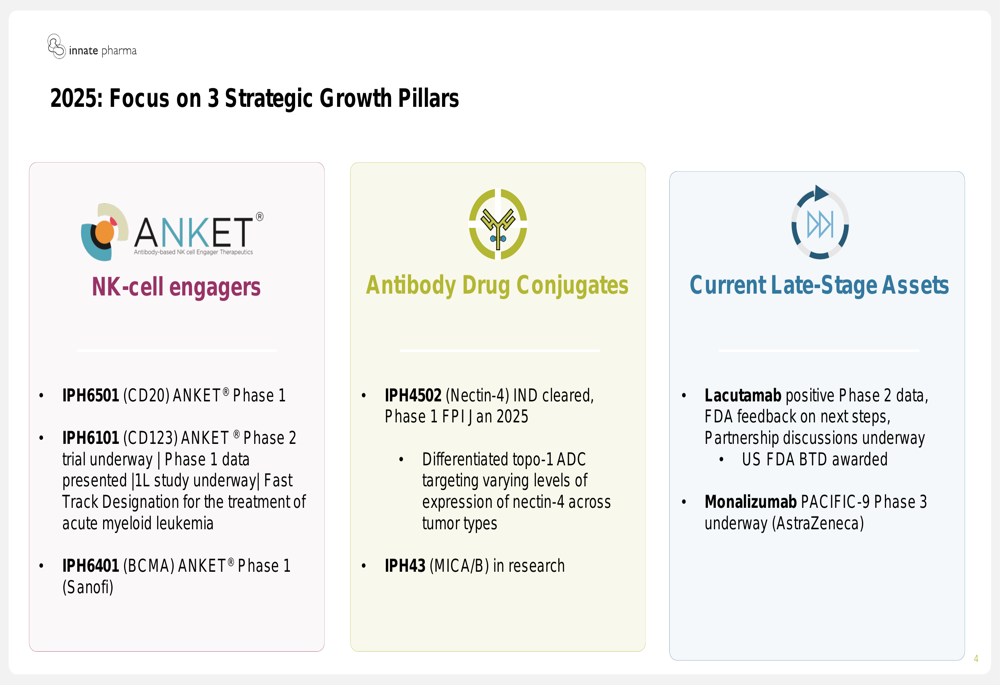
Strategic Initiatives
Innate Pharma’s three-pillar strategy focuses on developing first-in-class therapeutics across multiple modalities. The NK-cell engager platform, branded as ANKET® (Antibody-based NK cell Engager Therapeutics), includes IPH6501 (CD20) in Phase 1, IPH6101 (CD123) in Phase 2 with Fast Track Designation for acute myeloid leukemia, and IPH6401 (BCMA) in Phase 1 with partner Sanofi.
The company’s ADC portfolio is led by IPH4502 targeting Nectin-4, which entered Phase 1 in January 2025, while IPH43 (MICA/B) remains in research stage. Late-stage assets include Lacutamab, which received FDA Breakthrough Therapy Designation, and Monalizumab in the Phase 3 PACIFIC-9 trial conducted by AstraZeneca (NASDAQ:AZN).
The company’s comprehensive pipeline spans from preclinical to Phase 3 development across multiple therapeutic areas, as illustrated in this pipeline overview:
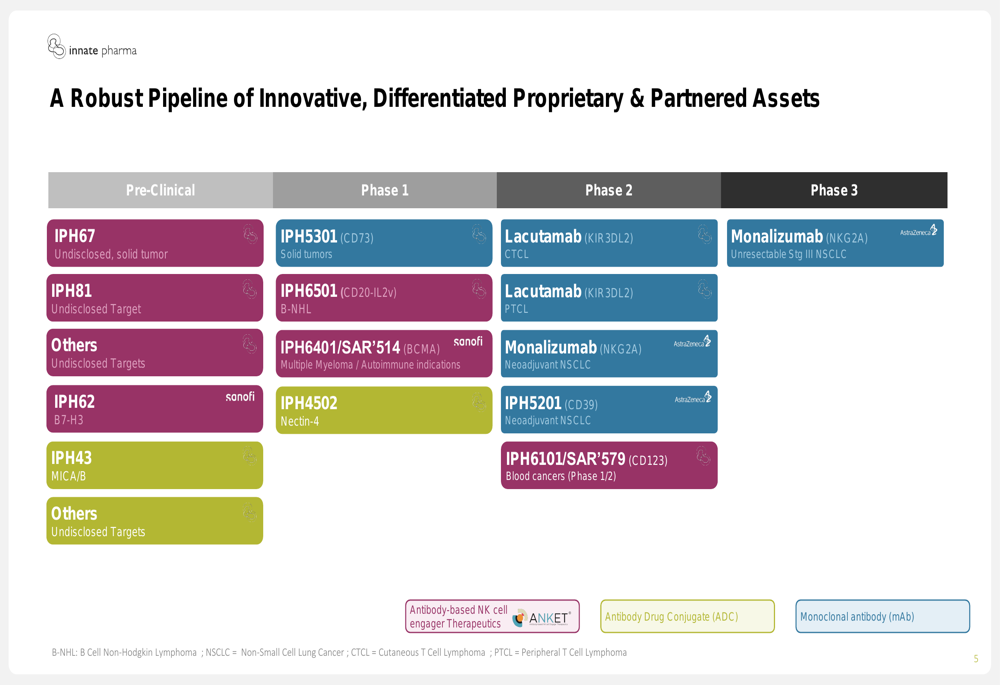
Detailed Pipeline Analysis
IPH6501, Innate’s lead proprietary ANKET® molecule, is a novel CD20-targeted tetra-specific natural killer cell engager designed to treat B-cell non-Hodgkin lymphoma. The molecule combines a CD20 tumor-associated antigen, IL-2v for NK cell proliferation, NKp46 binder for NK cell activation, and an Fc portion engaging the CD16 receptor. Preclinical data demonstrated stronger B-cell depletion with lower pro-inflammatory cytokine induction compared to CD20-TCE.
The molecular structure and mechanism of action are shown here:
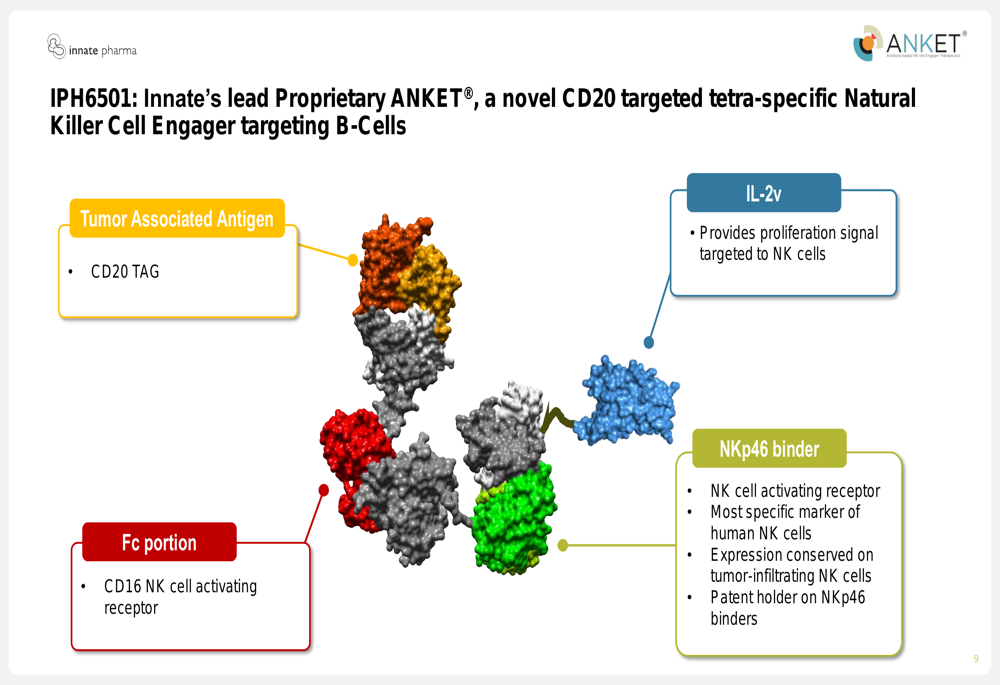
IPH4502, the company’s novel Nectin-4 ADC, features a proprietary humanized antibody with a cleavable, hydrophilic linker and exatecan payload (topoisomerase I inhibitor). Preclinical data showed activity in enfortumab vedotin (EV)/MMAE-resistant models and efficacy in tumors with low Nectin-4 expression.
The detailed composition of this differentiated ADC is illustrated below:
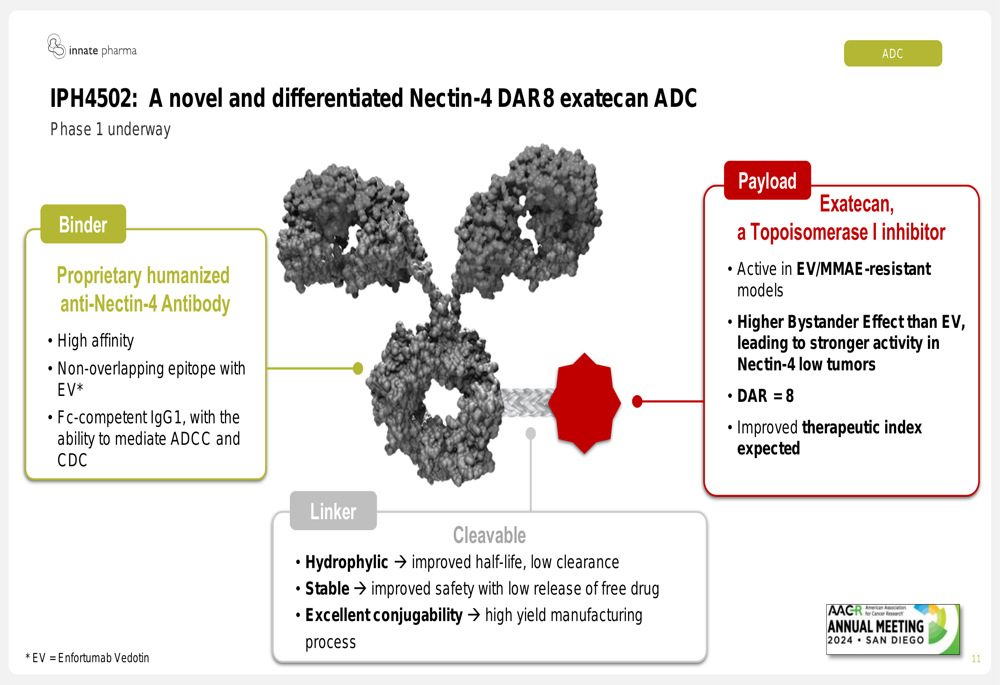
Lacutamab, targeting KIR3DL2 in cutaneous T-cell lymphomas (CTCL) and peripheral T-cell lymphomas (PTCL), received FDA Breakthrough Therapy Designation in February 2025 for relapsed/refractory Sézary Syndrome after at least two prior systemic therapies including mogamulizumab. The company has aligned with the FDA on the path to accelerated approval and plans to present long-term follow-up data from the TELLOMAK Phase 2 trial at ASCO 2025.
The regulatory pathway and mechanism of action for Lacutamab are shown here:
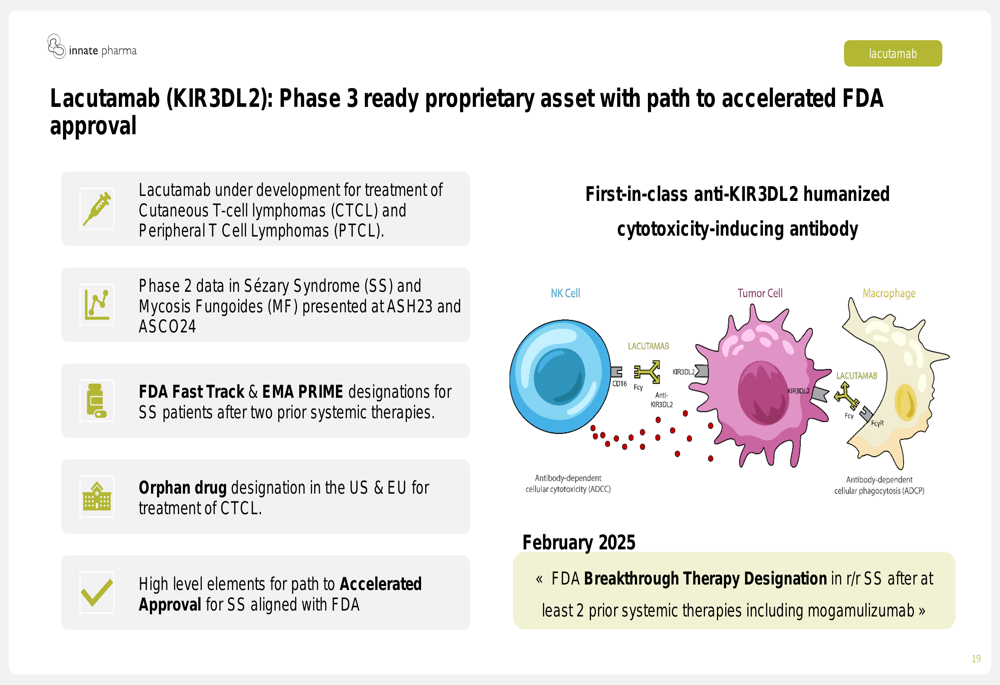
Partnership Developments
In April 2025, Sanofi strengthened its strategic relationship with Innate Pharma through a €15 million equity investment, increasing its ownership to 9.05% of shares. This builds upon their existing collaboration and license agreement covering two molecules: IPH6401/SAR’514 (BCMA ANKET) being pursued in autoimmune indications and IPH62 (B7-H3 ANKET), plus an option on an additional undisclosed target.
The collaboration makes Innate eligible for more than €1 billion in R&D and commercial milestones, with Sanofi taking responsibility for clinical development, manufacturing, and commercialization of the licensed assets.
The shareholder distribution following Sanofi’s investment is shown below:
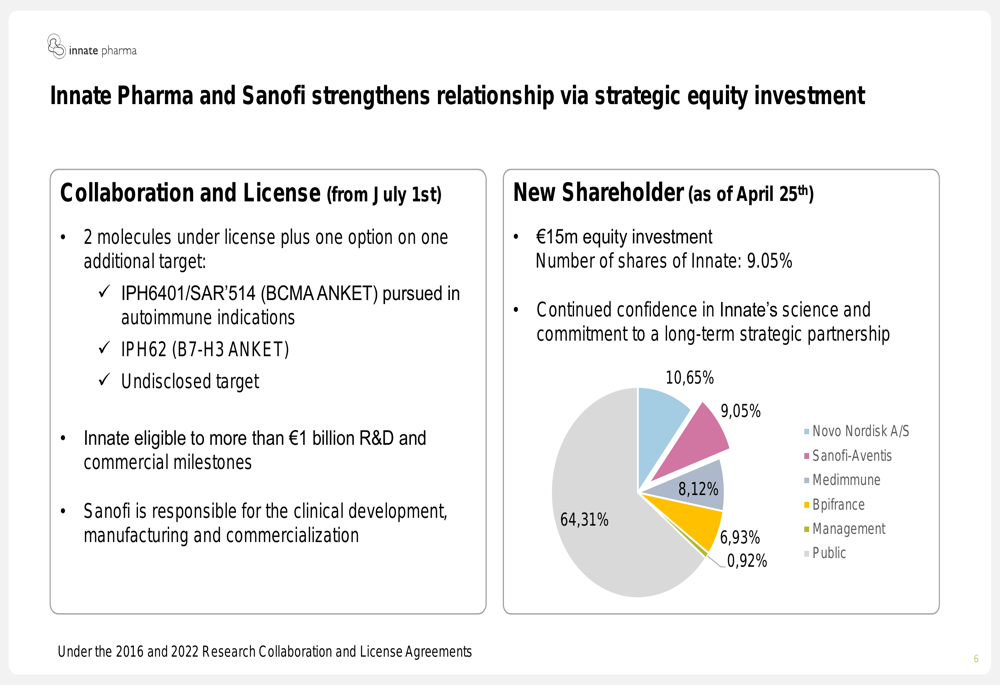
Forward-Looking Statements
Innate Pharma outlined several upcoming catalysts for 2025-2027. For proprietary assets, these include safety and preliminary efficacy data from the IPH6501 Phase 1 trial in 2025, the ongoing transfer of IPH6101 back to Innate, preliminary safety and efficacy data from the IPH4502 Phase 1 trial in 2026, and partnering discussions for Lacutamab in 2025.
For partnered assets, milestones include updates on SAR’514/IPH6401 with Sanofi in 2025, Monalizumab PACIFIC-9 Phase 3 readout with AstraZeneca in 2026, and IPH5201 MATISSE Phase 2 readout with AstraZeneca in 2026.
The company’s upcoming catalysts and newsflow are summarized in this timeline:
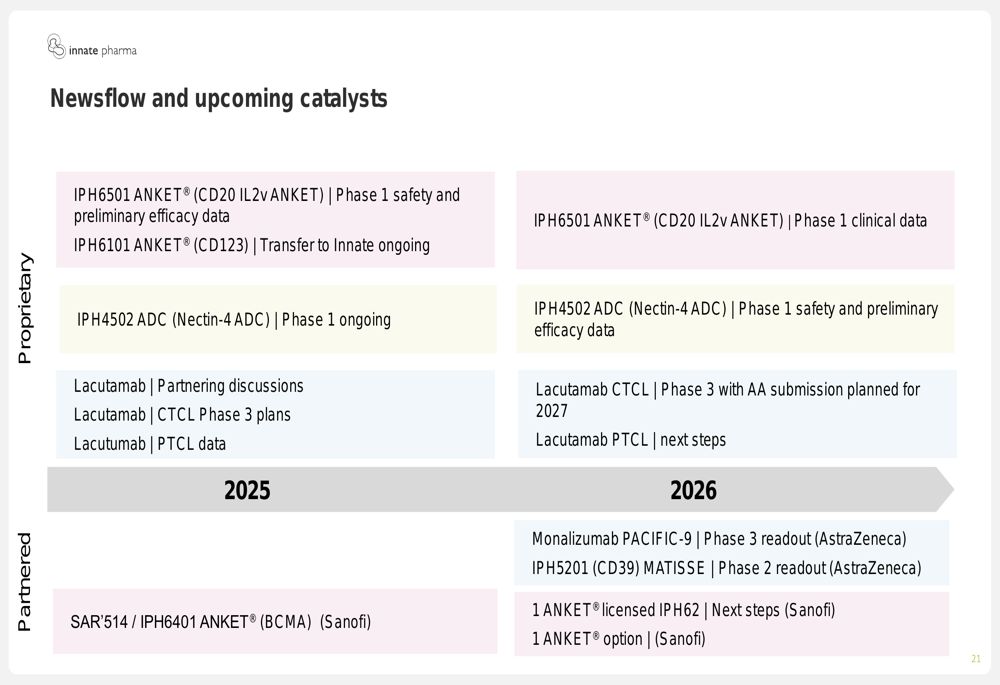
Financial Outlook
Innate Pharma reported a cash position of €72.5 million as of March 31, 2025, including short-term investments (€13.4 million) and non-current financial instruments (€10.6 million). This provides a runway until mid-2026, not accounting for the additional €15 million equity investment from Sanofi completed in April 2025.
According to the company’s Q4 2024 earnings report, revenue for 2024 reached CHF 20.1 million, primarily from collaboration licensing agreements, while operating expenses totaled CHF 71.7 million, with 73% allocated to research and development activities.
The company’s key financial metrics and strategic focus are summarized in these takeaways:
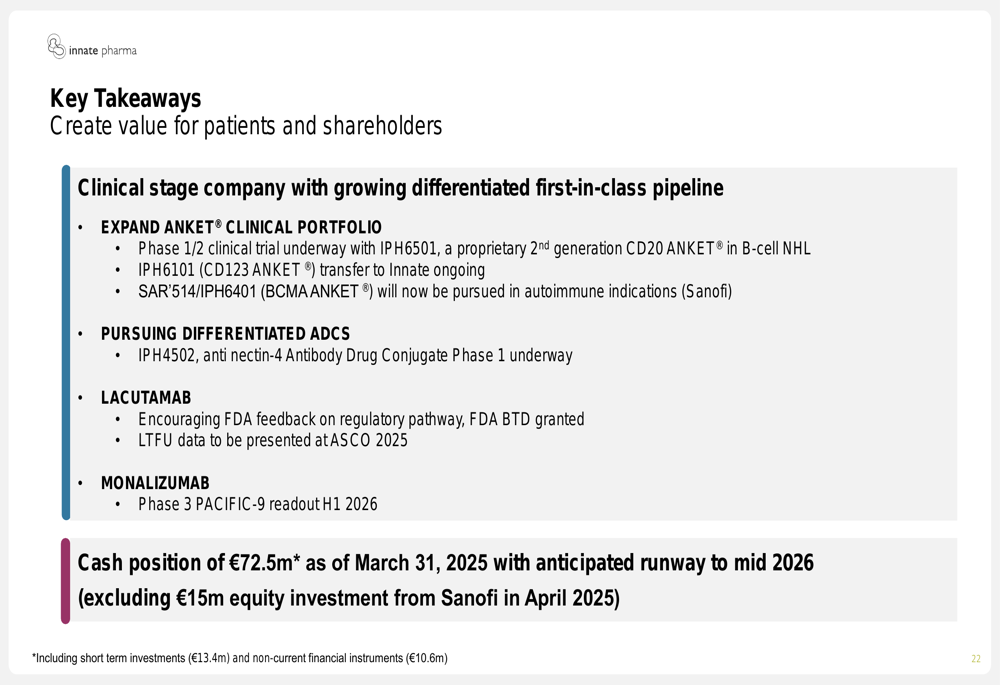
With multiple clinical-stage programs advancing and strengthened partnerships, Innate Pharma appears well-positioned to execute its strategy across its three growth pillars, though investors should note the company’s continued reliance on partnership revenues and equity investments as it works toward potential commercialization of its pipeline assets.
Full presentation:
This article was generated with the support of AI and reviewed by an editor. For more information see our T&C.
